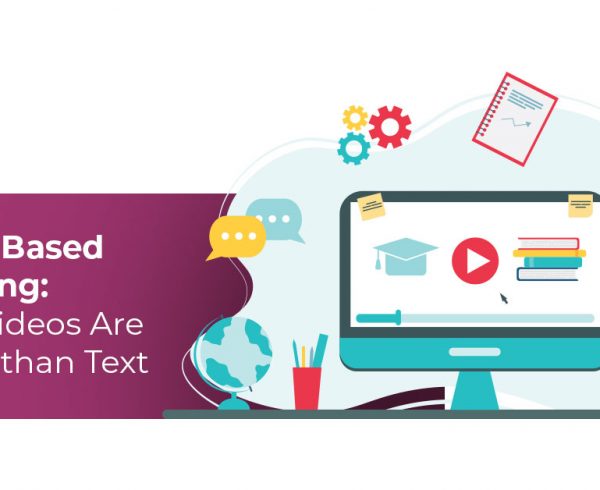Pondering whether you should invest your time and energy in implementing video-based learning? Fret not. This article answers all your questions about video-based learning. By the end of it, you’ll be able to make up your mind.
Let’s begin!
What is Video-Based Learning?
Video-based content, by its very nature, is engaging and attractive. Take YouTube, for example. It has billions of active users worldwide for the same reason. Before the advent of e-learning, textbooks were the staple of classroom-based teaching.
Things have changed now. E-learning necessitates the use of interactive content, without which learners can lose interest in no time. Video-based learning in higher ed holds students’ attention in a way that other learning formats cannot.
For this reason, video-based learning isn’t just a passing trend. It has immense benefits, which will be revealed later in this article.
Why Use it for Higher Ed Students?
The benefits of video-based learning are backed by solid research. In one such study published in February last year, researchers found that videos facilitate higher education learning. This study pooled a massive sample of 7,776 students.
Furthermore, according to a survey conducted on 1,673 students, 79% of respondents reported watching videos to identify practical applications of a subject and gain a better understanding of the topic. Most of these students found videos through the college library, Google, or YouTube.
What are their expectations with video-based learning? They search for videos that not only hold their attention but also quickly answer their questions. Apart from that, they are more likely to watch a video if the speaker is charismatic.
You don’t have to replace your existing teaching methods to incorporate videos, at least not entirely. However, they should be embedded throughout the e-learning course strategically. Creating an entire video course is another alternative. There are significant benefits of video-based learning in higher ed.
1. Deeper Understanding of the Concepts
Including videos in higher ed stimulates multisensory learning. When you watch a video, it engages more than two senses. A video typically contains text, audio, and pictures.
Your brain forges more cognitive connections while watching videos because so many senses are involved. Therefore, when learners watch them, they gain an in-depth understanding of the concepts being taught.
What Does Research Say About it?
Video-based learning enables deeper comprehension as well as retention of knowledge. This is also backed by research indicating that the human mind can process video-based content 60,000x faster than text-based content. Why is that?
It’s because of how the brain works. Reading text, for instance, requires the brain to process the information more “actively.” As you navigate the text, the brain analyzes, interprets, and predicts by working through every bit of information presented.
On the other hand, the brain takes a more “passive” approach when you’re watching a video. You’re still learning, but it’s sort of hand-held and automated – making it easier for the brain to process the visual and audio information.
Animated Explainer Videos
There are various methods of incorporating video-based learning in your e-learning curriculum. Take animated explainer videos, for example. They can help you explain the most complicated or abstract concepts in a fun and engaging manner.
You can make educative animated videos on topics such as space (wormholes, black holes, gravity, etc.), medicine, climate, human psychology, and so much more.
You might also like to read: Microlearning Videos – To Cut a Long Story Short
2. Enhanced Learning Experience
Videos don’t necessarily have to be something that learners passively watch. You can create and incorporate interactive videos too. What are those? Let’s understand with an example.
Try video-based branching narratives if you wish to enhance your students’ learning experience. In such types of videos, students are prompted with different scenarios. With every decision they make, a new plot unfolds. Therefore, each student watches a different set of videos.
Since they are responsible for making all the decisions throughout the video, they are naturally attentive, focused, and engaged.
Where Can it Be Implemented?
Video-based narratives, as mentioned, are great for providing an immersive learning experience. In this video-based learning format, students aren’t just watching the videos but interacting with them. Corporate compliance training programs utilize this content strategy.
Higher ed institutions can benefit greatly from this as well. Pick some subjects or topics that are typically very dull to teach and understand (which is why it’s used in compliance training) but extremely important at the same time. Use narratives to enrich the learning experience.
WHITEPAPER:
Maximizing the ROI & Business Impact of Enterprise Learning
3. Rapid Delivery of the Course
Today, higher ed institutions can launch the video-based learning format in no time. You can get experienced industry professionals to create highly effective videos for your students without setting your budget on fire. How incredible is that?
Think about it. Without modern digital content solution providers, you’d have to hire subject matter experts, in-house content creators, etc., which would have been a great option if it didn’t burn a hole in your pocket.
And these videos aren’t just a bunch of pictures haphazardly put together. These are highly engaging videos customized to your goals and objectives.
4. Wider Accessibility of Content
You’re teaching a generation of mobile-first users. As a higher ed institution, it’s vital to make your content accessible on various mobile devices, including smartphones and tablets that your learners are accustomed to.
Most e-learning professionals strive towards optimizing their content for both large (smart TVs and desktops) and small screens. Guess which e-learning format can be easily accessed across all devices? That’s right – video content!
For example, you can create bite-sized videos that students can access anytime, anywhere, and learn at their own pace. Video-based learning helps you achieve that. Here are few reasons why flexibility is essential for higher education.
Conclusion
Video-based learning is unlike any other format. It combines audio, text, and graphics to stimulate multisensory learning. When it comes to online learning, videos are quickly gaining a foothold. Not only do learners gain a deeper understanding of concepts, but they are also able to retain them more easily.
Based on your learning objectives, you can incorporate animated explainer videos, interactive narrative-based videos, or even simple how-to videos in your higher ed curriculum. The best part is, you don’t have to accomplish all of this yourself.
Instead, you can hire experts to create video-based e-learning content for you. Doing so is highly cost-effective as well. Not to mention, your students can access it across multiple devices.










